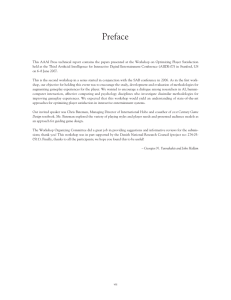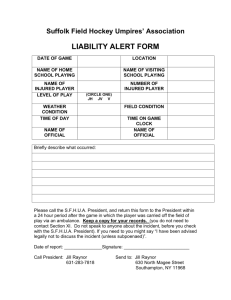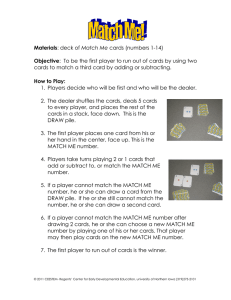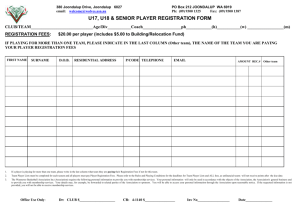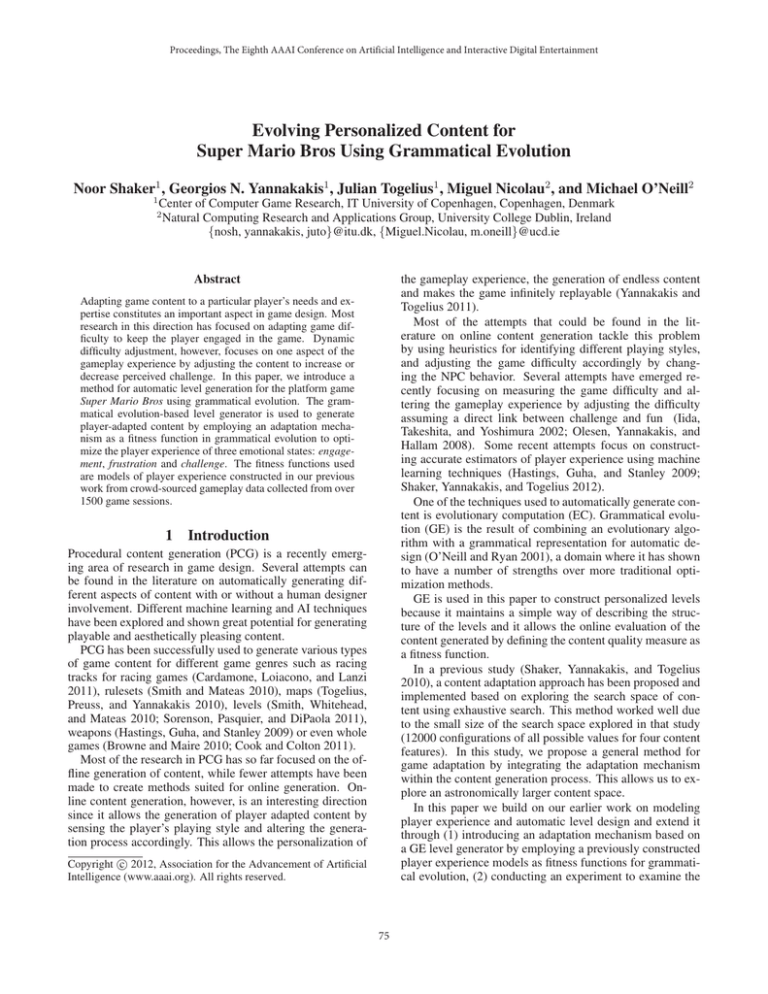
Proceedings, The Eighth AAAI Conference on Artificial Intelligence and Interactive Digital Entertainment
Evolving Personalized Content for
Super Mario Bros Using Grammatical Evolution
Noor Shaker1 , Georgios N. Yannakakis1 , Julian Togelius1 , Miguel Nicolau2 , and Michael O’Neill2
1
Center of Computer Game Research, IT University of Copenhagen, Copenhagen, Denmark
Natural Computing Research and Applications Group, University College Dublin, Ireland
{nosh, yannakakis, juto}@itu.dk, {Miguel.Nicolau, m.oneill}@ucd.ie
2
the gameplay experience, the generation of endless content
and makes the game infinitely replayable (Yannakakis and
Togelius 2011).
Most of the attempts that could be found in the literature on online content generation tackle this problem
by using heuristics for identifying different playing styles,
and adjusting the game difficulty accordingly by changing the NPC behavior. Several attempts have emerged recently focusing on measuring the game difficulty and altering the gameplay experience by adjusting the difficulty
assuming a direct link between challenge and fun (Iida,
Takeshita, and Yoshimura 2002; Olesen, Yannakakis, and
Hallam 2008). Some recent attempts focus on constructing accurate estimators of player experience using machine
learning techniques (Hastings, Guha, and Stanley 2009;
Shaker, Yannakakis, and Togelius 2012).
One of the techniques used to automatically generate content is evolutionary computation (EC). Grammatical evolution (GE) is the result of combining an evolutionary algorithm with a grammatical representation for automatic design (O’Neill and Ryan 2001), a domain where it has shown
to have a number of strengths over more traditional optimization methods.
GE is used in this paper to construct personalized levels
because it maintains a simple way of describing the structure of the levels and it allows the online evaluation of the
content generated by defining the content quality measure as
a fitness function.
In a previous study (Shaker, Yannakakis, and Togelius
2010), a content adaptation approach has been proposed and
implemented based on exploring the search space of content using exhaustive search. This method worked well due
to the small size of the search space explored in that study
(12000 configurations of all possible values for four content
features). In this study, we propose a general method for
game adaptation by integrating the adaptation mechanism
within the content generation process. This allows us to explore an astronomically larger content space.
In this paper we build on our earlier work on modeling
player experience and automatic level design and extend it
through (1) introducing an adaptation mechanism based on
a GE level generator by employing a previously constructed
player experience models as fitness functions for grammatical evolution, (2) conducting an experiment to examine the
Abstract
Adapting game content to a particular player’s needs and expertise constitutes an important aspect in game design. Most
research in this direction has focused on adapting game difficulty to keep the player engaged in the game. Dynamic
difficulty adjustment, however, focuses on one aspect of the
gameplay experience by adjusting the content to increase or
decrease perceived challenge. In this paper, we introduce a
method for automatic level generation for the platform game
Super Mario Bros using grammatical evolution. The grammatical evolution-based level generator is used to generate
player-adapted content by employing an adaptation mechanism as a fitness function in grammatical evolution to optimize the player experience of three emotional states: engagement, frustration and challenge. The fitness functions used
are models of player experience constructed in our previous
work from crowd-sourced gameplay data collected from over
1500 game sessions.
1
Introduction
Procedural content generation (PCG) is a recently emerging area of research in game design. Several attempts can
be found in the literature on automatically generating different aspects of content with or without a human designer
involvement. Different machine learning and AI techniques
have been explored and shown great potential for generating
playable and aesthetically pleasing content.
PCG has been successfully used to generate various types
of game content for different game genres such as racing
tracks for racing games (Cardamone, Loiacono, and Lanzi
2011), rulesets (Smith and Mateas 2010), maps (Togelius,
Preuss, and Yannakakis 2010), levels (Smith, Whitehead,
and Mateas 2010; Sorenson, Pasquier, and DiPaola 2011),
weapons (Hastings, Guha, and Stanley 2009) or even whole
games (Browne and Maire 2010; Cook and Colton 2011).
Most of the research in PCG has so far focused on the offline generation of content, while fewer attempts have been
made to create methods suited for online generation. Online content generation, however, is an interesting direction
since it allows the generation of player adapted content by
sensing the player’s playing style and altering the generation process accordingly. This allows the personalization of
c 2012, Association for the Advancement of Artificial
Copyright Intelligence (www.aaai.org). All rights reserved.
75
<level> ::= <chunks> <enemy>
<chunks> ::= <chunk> |<chunk> <chunks>
<chunk> ::= gap(<x>,<y>, <wg >,<wbef ore >,<waf ter >)
| platform(<x>,<y>,<w>)
| hill(<x>,<y>,<w>)
| cannon_hill(<x>,<y>,<h>,<wbef ore >,<waf ter >)
| tube_hill(<x>,<y>,<h>,<wbef ore >,<waf ter >)
| coin(<x>,<y>,<wc >)
| cannon(<x>,<y>,<h>,<wbef ore >,<waf ter >)
| tube(<x>,<y>,<h>,<wbef ore >,<waf ter >)
| <boxes>
efficiency of the adaptation mechanism on different playing
styles, (3) evolving levels that optimize the player experience of the three emotional states: engagement, frustration
and challenge and (4) conducting a thorough analysis on the
obtained results to validate the adaptation mechanism and
investigate the relationship between the emotional states.
The testbed platform game used is a modified version of
Markus “Notch” Persson’s Infinite Mario Bros (IMB). For
a detail description about the game the reader may refer
to (Togelius, Karakovskiy, and Baumgarten 2010).
2
<boxes> ::= <box_type> (<x>,<y>)2 | ...
| <box_type> (<x>,<y>)6
GE-based Level Generator
Design Grammar
<box_type> ::= blockcoin | blockpowerup
| rockcoin | rockempty
GE is a grammar-based form of genetic programming (GP)
that uses a design grammar (DG) as its input to specify the
syntax of possible solutions (O’Neill and Ryan 2001).
In the case of IMB levels, the design grammar is used
to represent the underlying structure of the levels. The levels in IMB are constructed by placing different chunks in a
two-dimensional map of predefined width and height. Each
chunk can be one of the following: a platform, a gap, a tube,
a cannon, a box, a coin, or an enemy. In order to allow efficient representation and variation in the design, the considered chunks have been categorized into two types: obstructplatforms which block the path and enforce the player to
perform a jump action, and hills that give the player the option to either pass through or jump over them.
The DG has been defined in a way that allows the placement of the chunks within the level map in no specific order. Each chunk is given a set of parameters that defines its
characteristics; the list of parameters includes: the x and y
coordinates of the starting position of the chunk; the height,
h; the width of a gap, wg ; the width of the platform before wbef ore and after waf ter specific game elements (gaps,
tubes, and cannons); the horizontal spawning of a platform
or a hill, w; and the number of coins, wc . A simplified version of the DG is presented in Figure 1.
Enemies are placed on platforms after the level design
have been constructed by evolving the position of each enemy and map it onto the possible positions of flat areas.
<enemy> ::= (koopa | goompa)(<x>) 2 | ...
| (koopa | goompa)(<x>) 10
<x> :: = [5..95] <y> ::= [3..5]
<wg > ::= [2..5] <w> ::= [2..7]
<h> ::= [3..5]
<wbef ore > ::= [2..6]
<waf ter > ::= [2..6] <wc > ::= [2..7]
Figure 1: A simplified version of the final grammar employed to specify the design of the level. The superscripts
(2, 6 and 10) are shortcuts for the number of repetitions.
on a flat space on the ground, Pr ; the number of powerups;
and the number of boxes.
It is worth noting that the levels used in that experiment
were constructed using a very different content generator
than the one proposed in this paper which has a different
expressivity range (Shaker et al. 2012), and hence we anticipate that using the constructed models as fitness functions
would give us only an estimation of the content quality.
The fitness value assigned for each individual (level) in
the evolutionary process is the output of the model which
is the predicted value of engagement, frustration or challenge. The output is calculated by computing the values of
the models’ inputs; this includes the values of the six content
features which are directly calculated for each level design
generated by GE and the values of the gameplay features
estimated from the player playing style while playing a previous level. The search for the best content features that
optimize particular affect is guided by the models prediction
of the affective states, with a higher fitness given to the individuals that are predicted to be more engaging, frustrating
or challenging for a particular player.
Fitness Function
The existing GEVA software (O’Neill et al. 2008) has been
used to implement the needed functionalities of GE. The fitness functions used by GE are the player experience models
constructed in our previous study to predict players’ reported
level of engagement, frustration and challenge from six key
features of game content and players’ playing style (Shaker,
Yannakakis, and Togelius 2011). The inputs for each model
are selected from statistical gameplay features calculated
from the interaction between the player and the game and
all six content features that have been included in the inputs in order to allow for control over the generated content,
namely, the number of gaps in the level; the average width of
gaps; the number of enemies; enemies placement, Ep which
has been determined by three probabilities which sum to
one: on or under a set of horizontal blocks, Px ; within a
close distance to the edge of a gap, Pg and randomly placed
Experimental Setup
The GE experimental parameters used are the following:
one run of 50 generations with a population size of 100 individuals. This allows a compromise between the efficiency
in finding the best individual and the amount of time needed
to apply a realistic online adaptation (each generation round
takes about 10.4 seconds). The ramped half-and-half initialization method was used and the maximum derivation tree
depth was set at 100, tournament selection of size 2, int-
76
flip mutation with probability 0.1, one-point crossover with
probability 0.7, and 3 maximum wraps were allowed.
3
On-line Content Generation for
Optimizing Player Experience
The methodology proposed for generating game content using GE has been employed to generate personalized content.
While the level is being played, the playing style is recorded
and then used by GE to evaluate each individual design generated. Each individual is given a fitness according to the
recorded player behavior and the values of its content features. The best individual found by GE is then visualized
for the player to play.
We assume that the player’s playing style is largely maintained during consecutive game sessions and thus his playing characteristics in a previous level provide a reliable estimator of his gameplay behavior in the next level. To compensate for the effect of learning while playing a series of
levels, the adaptation mechanism only considers the recent
playing style, i.e. that which the player exhibited in the most
recent level. Thus, in order to effectively study the behavior of the adaptation mechanism, it is important to monitor
this behavior over time. For this purpose, AI agents have
been employed to test the adaptation mechanism since this
requires the player to play-test a large number of levels.
Figure 2: Average and standard deviation values of several
gameplay statistical features that have been extracted from
100 different sessions played by the two agents.
found. The same procedure is repeated for 100 rounds taking into account the player behavior in the previous round to
evaluate the level designs in the current round.
Figure 3 presents the fitness values obtained for the best
individual in each round when optimizing the level design to
maximize engagement, frustration and challenge for the A*
and Sergio’s agent while monitoring the models’ predictions
of the other emotional states than the one optimized.
The results presented in Table 1 show that, using the adaptation mechanism, we were able to construct levels for the
two agents with high predicted values across the three affective states. The adaptation mechanism appears to maintain
the same level of predicted engagement for the two agents
compared to the values obtained for frustration and challenge as can be seen from the standard deviations values.
By examining the gameplay data, we observed that most
of the low prediction values obtained when predicting challenge are the cause of outliers in the time spent playing (very
short or very long gameplay sessions). These outliers are the
result of dying very early in the level or being stuck in a dead
end as a result of the agents’ incapacity to backtrack, which
will eventually lead to losing the game by reaching the maximum session time allowed. The same argument holds for
predicted frustration but with different effects; while short
gameplay sessions resulted in a high level of frustration, being stuck in a dead end till the session time expires resulted
in low prediction values of frustration. However, the length
of the gameplay session appears to have less influence of the
prediction of engagement.
AI Agents
Two AI controllers submitted to the Gameplay track of the
Mario AI Competition 1 have been adopted to test the adaptation mechanism. The first agent is based on the A* search
algorithm and the second is based on a simple heuristic function written by Sergio Lopez (Togelius, Karakovskiy, and
Baumgarten 2010). These two agents have been chosen because of their good performance and because they exhibit
quite different playing styles. Figure 2 presents several statistical gameplay features extracted from 100 levels played
by each agent where the differences in playing styles can be
clearly observed; while the A* agent tends to spend most
of the time running and jumping, Sergio’s agent appears to
be moving slower and performing jumps only when necessary which leads to more time spent to finish the levels compared to the time needed by the A* agent. In general, the A*
agent shows better performance than Sergio’s agent by winning more frequently. Using such controllers, we are able to
test the adaptation mechanism ability to recognize different
playing characteristics and evolve levels accordingly.
The methodology proposed to test the adaptation mechanism is as follows: each AI agent plays a test level while its
behavior is recorded. The evolution process is then started
and GE is initialized with a random population of level designs, each individual is ranked according to the predicted
player experience it provides (as predicted by the player experience models) given the player behavior in the test level
and the content features extracted from the level design. The
levels are then evolved, and the AI agent plays the best level
1
Table 1: Average fitness values obtained for the evolved levels across the three emotional states for each agent along
with the standard deviations.
Engagement
Avg
78.23% ± 1.88
Avg
74.01% ± 2.56
F rustration
A* agent
79.06% ± 7.36
Sergio’s agent
80.59% ± 10.58
Challenge
66.2% ± 10.23
61.25% ± 8.75
Figure 4 presents the best levels generated to optimize
players experiences. Levels with varying content parameters have been evolved for each agent across the three emotional states. The levels can be analyzed according to the
six content features optimized to maximize specific expe-
www.marioai.org
77
100
80
70
60
50
40
30
20
5
10
15
20
25
30
35
40
45 50 55
Evolved levels
60
65
70
75
80
85
90
95
50
40
30
20
5
10
15
20
25
30
35
40
45 50 55
Evolved levels
60
65
70
75
80
85
90
95
100
100
Frustration
Engagement
Challenge
80
Frustration
Engagement
Challenge
90
Fitness (models’ prediction)
90
Fitness (models’ prediction)
60
(b) Optimized predicted engagement for Sergio agent.
100
70
60
50
40
30
20
80
70
60
50
40
30
20
10
10
5
10
15
20
25
30
35
40
45 50 55
Evolved levels
60
65
70
75
80
85
90
95
0
0
100
5
10
15
20
25
30
35
40
45 50 55
Evolved levels
60
65
70
75
80
85
90
95
100
(c) Optimized predicted frustration for the A* agent.
(d) Optimized predicted frustration for Sergio agent.
100
100
Challenge
Engagement
Frustration
80
70
60
50
40
30
20
10
0
Challenge
Engagement
Frustration
90
Fitness (models’ prediction)
90
Fitness (models’ prediction)
70
0
0
100
(a) Optimized predicted engagement for the A* agent.
0
0
80
10
10
0
0
Engagement
Frustration
Challenge
90
Fitness (models’ prediction)
Fitness (models’ prediction)
100
Engagement
Frustration
Challenge
90
80
70
60
50
40
30
20
10
5
10
15
20
25
30
35
40
45 50 55
Evolved levels
60
65
70
75
80
85
90
95
0
0
100
5
10
15
20
25
30
35
40
45 50 55
Evolved levels
60
65
70
75
80
85
90
95
100
(f) Optimized predicted challenge for Sergio agent.
(e) Optimized predicted challenge for the A* agent.
Figure 3: The fitness function for the optimized levels evolved for each emotional state while monitoring the models’ prediction
of the other emotional states.
rience. The diversity in the structure reflects the differences
in playing style between the two agents; since Sergio’s agent
exhibit an average playing style (with no running and jumping only when necessary), the evolved level for optimizing
engagement presents a flat level with some coins while the
most engaging level for the A* agent (which plays more
like an expert player by running and jumping throughout
the level) contains gaps and enemies with no coins. The
best levels evolved for optimizing frustration, on the other
hand, exhibit more similar structure with both of them having the same number of gaps while differing in the number
and placement of enemies; a small number of enemies scattered around gaps has been generated for the A* agent, while
more enemies randomly placed around the level have been
evolved for the most frustrating level for Sergio’s agent. A
slightly more challenging level with more gaps has been
evolved for Sergio’s agent than the one generated for the A*
agent.
Figure 5 presents statistics for the six content features
used to evaluate game content extracted from the 100 levels
generated to optimize the prediction of the three emotional
states. All values are normalized to the range [0,1] using
standard max-min normalization. As can be seen from the
figure, the most engaging levels evolved for optimizing engagement for the A* agent contain more and wider gaps with
enemies mostly placed around gaps and blocks compared
to less and narrower gaps with enemies scattered randomly
around the levels observed for the levels optimized for Ser-
gio’s agent. The opposite observations have been obtained
from the levels optimized for challenge. It hence appears
that the approach was able to recognize the differences in
the playing styles and consequently evolve levels with different characteristics to optimize particular player experience.
On the other hand, similar average values for the content
features have been observed from the maximum frustrating
levels for the two agents.
4
Statistical Analysis
We performed statistical tests (correlation coefficients) to
further investigate the results obtained, the method ability
to recognize and adapt to particular playing style and the relationship between the three emotional states.
The first test has been conducted to test the ability of the
adaptation approach to recognize particular playing styles
and adapt accordingly. This is done by testing for significant
differences in the predictions obtained from the 100 best
levels evolved for each agent. The statistical test showed
that the adaptation mechanism evolved significantly more
engaging and challenging levels for the A* agent than the
ones generated for Sergio’s agent while no significant difference has been observed for the levels evolved to maximize
frustration for the two agents (significance is determined by
p < 0.01). It, hence, appears that it is easier to generate
engaging and challenging levels for a player with an expert
style than for a player with an average playing style.
To investigate the intra-correlations between the three
78
emotional states, we calculated the correlations between the
predictions of an optimized affective state and the predictions of the other non-optimized emotional states. The results presented in Table 2 show that for the two agents,
evolving engaging levels resulted in levels that are also challenging while generating challenging levels were found to
generate levels that are less engaging for the two agents.
On the other hand, different effects have been observed
between the predictions of engagement and frustration;
while evolving engaging levels were also found to generate
frustrating levels as evidenced by the predictions of these
two emotional states to be positively correlated for the A*
agent, these emotional states were found to be strongly negatively correlated for Sergio’s agent. Evolving frustrating
levels, on the other hand, resulted in levels that are also engaging for the two agents.
As for the relationship between predicted frustration and
challenge, the correlation analysis showed that when optimizing predicted frustration, less challenging levels are generated for the two agents. However, predicted challenge and
frustration were found to be strongly positively correlated
when evolving challenging levels for the two agents.
(a) Evolved level for maximum engagement for the A*
agent
(b) Evolved level for maximum engagement for Sergio’s
agent
(c) Evolved level for maximum frustration for the A*
agent
(d) Evolved level for maximum frustration for Sergio’s
agent
Table 2: Correlation coefficient values obtained between the
predictions of engagement (E), frustration (F) and challenge
(C) when optimizing each of these affective states (columns)
while monitoring the prediction of the other emotional states
(rows). Strong correlations are presented in bold.
E
E
F
C
0.23
0.04
(e) Evolved level for maximum challenge for the A* agent
Optimized affective states
A* agent
Sergio’s agent
F
C
E
F
C
0.62
−0.34
0.613 −0.4
0.31
−0.45
0.36
−0.78
0.12
−0.67
(f) Evolved level for maximum challenge for Sergio’s
agent
This variety of relationships observed among the predictions of the emotional states between the agents reflects the
method’s ability to recognize different playing styles and
evolve levels with different characteristics.
5
Figure 4: The best levels evolved to maximize predicted engagement, frustration and challenge for the two agents.
of engagement and challenge for a player with an expert
style than for a player with an average playing style.
The results obtained revealed interesting relationships
among the predictions of the emotional states. Engaging
levels were found to also be challenging in general while
challenging levels are not necessarily engaging. The same
observation has been obtained between predicted frustration
and challenge; the features that play a role in generating
challenging levels appear to also have a positive effect on
the perceived frustration, while the influence of the features
positively affecting perceived frustration has been observed
to be negative on predicted challenge. The right amount of
frustration should be present in a level for it to be engaging, this also depends on the playing style; while engaging
levels are also found to be frustrating for some players, other
players might enjoy less frustrating levels. Although this paper focuses on optimizing one aspect of player experience,
it is interesting is to investigate the use of multi-objective
Conclusions and Future Directions
The paper introduced an approach for automatic level design and adaptation using grammatical evolution. A design
grammar was defined to represent the underlying structure
of the levels in Super Mario Bros and evolution was performed to select the best individuals based on their potential
in optimizing a particular affective state for specific playing
style. To this end, previously constructed player experience
models that map game content to reported player experience
(engagement, frustration and challenge) were utilized as fitness functions. Two AI agents with different playing styles
were used to test the adaptation approach. The results illustrate the method’s ability to recognize differences in playing
styles and generate content accordingly.
The analysis conducted to test for the method validity and
the dependencies among the predictions of the emotional
states showed that it is easier to optimize player experience
79
racing game. In Genetic and Evolutionary Computation Conference, GECCO, 12–16.
Cook, M., and Colton, S. 2011. Multi-faceted evolution of simple arcade games. In IEEE Conference on Computational Intelligence and Games (CIG), 289–296.
Hastings, E. J.; Guha, R. K.; and Stanley, K. O. 2009. Evolving
content in the galactic arms race video game. In Proceedings of
the 5th international conference on Computational Intelligence
and Games, CIG’09, 241–248. Piscataway, NJ, USA: IEEE Press.
Iida, H.; Takeshita, N.; and Yoshimura, J. 2002. A metric for entertainment of boardgames: its implication for evolution of chess
variants. In IWEC, 65–72.
Olesen, J.; Yannakakis, G.; and Hallam, J. 2008. Real-time challenge balance in an rts game using rtneat. In IEEE Symposium On
Computational Intelligence and Games, 2008, 87–94. IEEE.
O’Neill, M., and Ryan, C. 2001. Grammatical evolution. IEEE
Transactions on Evolutionary Computation 5(4):349–358.
O’Neill, M.; Hemberg, E.; Gilligan, C.; Bartley, E.; McDermott,
J.; and Brabazon, A. 2008. Geva: grammatical evolution in java.
ACM SIGEVOlution 3(2):17–22.
Shaker, N.; Nicolau, M.; Yannakakis, G.; Togelius, J.; and
O’Neill, M. 2012. Evolving Levels for Super Mario Bros Using
Grammatical Evolution. In IEEE Transactions on Computational
Intelligence and Games (CIG).
Shaker, N.; Yannakakis, G. N.; and Togelius, J. 2010. Towards
Automatic Personalized Content Generation for Platform Games.
In Proceedings of the AAAI Conference on Artificial Intelligence
and Interactive Digital Entertainment (AIIDE). AAAI Press.
Shaker, N.; Yannakakis, G. N.; and Togelius, J. 2011. Feature
Analysis for Modeling Game Content Quality. In IEEE Transactions on Computational Intelligence and Games (CIG), 126–133.
Shaker, N.; Yannakakis, G. N.; and Togelius, J. 2012. Digging deeper into platform game level design: session size and
sequential features. In Proceedings of the European Conference
on Applications of Evolutionary Computation (EvoApplications).
Springer LNCS.
Smith, A. M., and Mateas, M. 2010. Variations Forever: Flexibly Generating Rulesets from a Sculptable Design Space of MiniGames. IEEE Transactions on Computational Intelligence and AI
in Games.
Smith, G.; Whitehead, J.; and Mateas, M. 2010. Tanagra: A
mixed-initiative level design tool. In Proceedings of the International Conference on the Foundations of Digital Games, 209–216.
ACM.
Sorenson, N.; Pasquier, P.; and DiPaola, S. 2011. A generic approach to challenge modeling for the procedural creation of video
game levels. IEEE Transactions on Computational Intelligence
and AI in Games 3(3):229–244.
Togelius, J.; Karakovskiy, S.; and Baumgarten, R. 2010. The
2009 mario ai competition. In IEEE Congress on Evolutionary
Computation (CEC), 1–8. IEEE.
Togelius, J.; Preuss, M.; and Yannakakis, G. 2010. Towards
multiobjective procedural map generation. In Proceedings of the
2010 Workshop on Procedural Content Generation in Games, 3.
ACM.
Yannakakis, G., and Togelius, J. 2011. Experience-driven procedural content generation. IEEE Transactions on Affective Computing 2(3):147–161.
Figure 5: Average and standard deviation values of six statistical content features extracted from 100 levels evolved to
optimize predicted engagement (E), frustration (F) and challenge (C) for the two agents. Enemies placement Ep = 0
when Pg = 80%, Ep = 0.5 when Px = 80% and Ep = 1
when Pr = 80%.
optimization techniques to optimize, for example, engagement and challenge while minimizing frustration. This will
help us explore new dimensions of player experience and ultimately generate content that maximizes some dimensions
while minimizing others to optimize player experience.
The analysis presented focuses on optimizing specific predicted affective state for a particular playing style. Future
directions include testing the method’s ability to generalize
over different playing styles. This could be tested by setting
different players to play in turns and monitoring the content
evolution, similar to an experiment conducted in our previous study (Shaker, Yannakakis, and Togelius 2010).
There is an important limitation imposed in the approach
followed that concerns the use of player experience models constructed based on levels generated by a very different content generator. A previous study (Shaker et al. 2012)
showed that the two generators have very different expressive ranges; while the previous generator generates content
by varying the values of six content features with all other
dimensions being fixed, the GE-based generator explores the
content space without such limitations. It is, therefore, important to test and validate the adaptation mechanism with
human players. This could be done by letting human players
play and compare adapted and non adapted generated levels.
It is also necessary to study the effect of the content features
on players’ judgment since we anticipate that new factors of
level design will play a role in human judgment. The discovery of more relevant features will allow us to model player
experience with better accuracy.
Acknowledgements
The research was supported in part by the Danish Research
Agency, Ministry of Science, Technology and Innovation;
project ”AGameComIn” (274-09-0083).
References
Browne, C., and Maire, F. 2010. Evolutionary game design. IEEE
Transactions on Computational Intelligence and AI in Games,
2(1):1–16.
Cardamone, L.; Loiacono, D.; and Lanzi, P. 2011. Interactive
evolution for the procedural generation of tracks in a high-end
80

